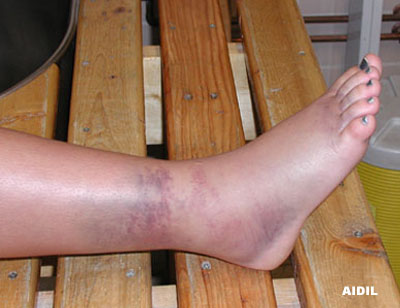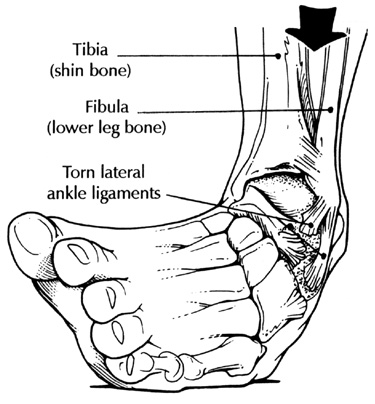|
Treating Ankle SprainsHere, we'll discuss treating ankle sprains, together with anatomy and the classifications of these injuries. These injuries are often under-diagnosed and under-appreciated in their severity.
The severe ankle sprain is one of the most common injuries in sporting activities and can be responsible for lost time at work, lost participation in sports and can set the table for future, recurrent injuries of the same type. Treating ankle sprains can be costly to an individual in terms of time and money.
Ankle sprains involve injury and damage to the surrounding ligament structures that serve to stabilize it. The mechanism of injury is typically a rolling over, or “inversion” action. The ankle can also roll outward and sustain an “eversion” type injury, but this is a bit less common and can usually be found in fracture conditions. This can happen frequently in sporting injuries such as football when a player is being tackled, or when the foot is planted and a change in direction of movement occurs. These injuries are also fairly commonplace in basketball where several players are in close quarters, increasing the potential for stepping on another person's foot, or a plant-and-change-direction maneuver occurs as well.
The ligaments involved in this injury type are the ones located on the lateral, or outer, aspect of the ankle. The three major ones located here are: the anterior talo-fibular, the posterior talo-fibular, and the calcaneo-fibular ligaments. The level of severity is determined by their degree of involvement and damage. Ankle sprain injuries are typically divided into three main categories of severity; the Grade I, Grade II and Grade III. We’ll discuss treating ankle sprains by grade, and how these grades are determined. In most all instances, the relative healing time for these ligament injuries is approximately 6-8 weeks. This typically does not include time spent in physical therapy to rehabilitate and strengthen the lower extremity. Treating ankle sprains is largely dependent upon the severity and the overall activity levels of the individual. The classification of these injuries are listed below: In the movie below, be sure to click on "Select Condition" and choose "Foot/Ankle" from the drop-down menu to learn more...
Grade I:This is considered the mildest form of ankle sprain. The injury typically involves stretching (and occasionally very minor partial tearing) of the lateral ligaments, usually the anterior talo-fibular ligament. This level of severity usually carries with it some degree of pain, swelling and possible bruising (ecchymosis). People are usually able to walk with minimal discomfort and without crutches; however they may not be able to perform activities like jogging or jumping. Grade I injuries are typically treated with ice, rest, occasionally the use of an ankle support, pain medications and/or anti-inflammatory agents, activity alteration and, time. Grade II:Grade II, or second-degree, sprains are more severe than Grade I injuries. They typically involve more pain, swelling and bruising. There is more damage to the ligament tissue through tearing, but still the ankle remains fairly stable. Frequently, the Grade II ankle sprain requires the use of crutches because of the degree of pain and swelling. Because blood can develop in the ankle joint itself, there may be considerable discomfort with attempts at walking. Treatment of Grade II injuries may include some level of formal immobilization such as a cast or splint, followed by physical therapy. More and more frequently, Grade II injuries are seen in physical therapy clinics very early after onset, because the prevailing opinions are that these injuries ultimately do as well, or better, than those that have been immobilized for any length of time. Grade III:This is traditionally the most severe of the ankle ligament injuries. Considerable tearing and damage to ligament structures occurs here and the ankle is typically unstable to side-to-side / inversion forces. The use of a walker or crutches is usually necessary, and the ankle may need strict immobilization until pain and swelling levels improve. Occasionally the ankle may need surgical repair or ligament reconstruction later down the road if it continues to be unstable and / or a history of repeat injuries develops.
Leave Treating ankle Sprains; return to Home Page
|

"We hope you enjoy your journey through Bone and Joint Pain.com"


